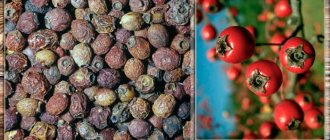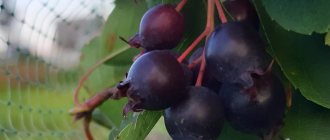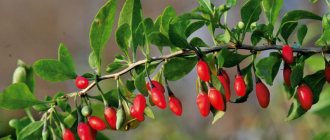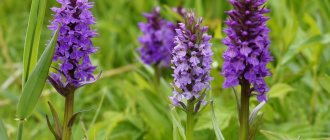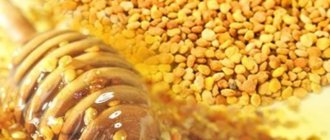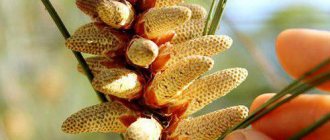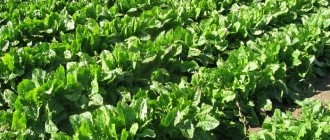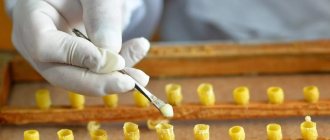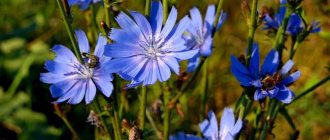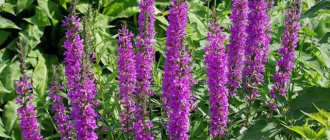Blueberries are the state symbol of American New Jersey. There is a berry museum there. It used to be a farm. Tall blueberry bushes have been cultivated there since 1916. The process was led by Frederick Coville and Elizabeth White. But wild blueberries are considered the most delicious. This also exists in Russia.
Description and features
Blueberry is a shrub. It is usually about 30 centimeters in height. The plant is highly branched. Each stem points upward and has a circular cross-section. The color of the trunks is brown. Blueberry leaves are ovate, covered with a waxy coating. The front side of the plates is dark green. The bottom of the leaves is bluish. They sit on short petioles and fall off by autumn.
The flowers of the plant are white or pinkish, collected in racemes. They are rare and face down. Peduncles emerge from the axils of the leaves. The buds themselves resemble bells or water lilies. Each one is about half a centimeter long.
Blueberry flowers are bisexual and bloom from May to June. The fruits are round and bluish-blue. Under the skin there is green pulp. The diameter of the berries reaches 1 centimeter. Blueberry roots are characterized by endotrophic mycorrhiza, that is, symbiosis with soil fungi.
They are of a special type, called heather. Blueberries belong to this class of plants. Blueberries are also included in this category. It was there that heather mushrooms were first discovered. Without them, the berry does not grow. Accordingly, in the wild, blueberries are found where there is the desired mushroom in the soil.
Blueberries grow safely and bear fruit only in acidic soils.
Transplanting garden blueberries: how to replant?
Replanting a shrub may be a necessity, which will allow the plant to bear fruit and no longer get sick. The transplant should not be deeper than it was planted before, namely at a level of 5 cm, when the soil covers the roots. Transplantation can only be done on an adult plant (when the seedling is at least 50 cm tall).
IMPORTANT: Before you plant the shrub in new soil, you should completely remove all buds and green shoots. When replanting, be sure to fertilize the soil.
Where does it grow
Where blueberries grow , the soils are swampy and acidic. On poor soils, for example, sandy, the berry is found, but small, literally surviving, not living. In addition to the abundance of moisture and acidity of the soil, blueberries are demanding of light. It shouldn’t be scorching, but the shrub doesn’t like shade either.
The plant finds suitable conditions in regions with long, harsh winters and short but hot summers. In Russia, these are territories from the Urals to the Far East. There are also a lot of blueberries in America. From there, scientists believe, the berry spread throughout the world along with settlers. The southern border of growth is the state of California.
In the north, blueberries “go” right up to the permafrost. The layer of organic matter on it is usually thin. There is abundant moss on top. It’s difficult to call this soil, but the heroine of the article is satisfied. While withstanding prolonged cold, blueberries also successfully tolerate short-term droughts and periods of sweltering heat.
If the bush is flooded for a while, this will not cause its death either. The main thing is that the listed phenomena are short-lived. The listed preferences of blueberries characterize it mainly as a tundra plant. It does not look for easy ways, since it is not found on fertile, well-warmed and illuminated soils.
But on those after the fire, blueberries are the first guest. The properties of blueberries allow it to “penetrate” mountains up to an altitude of 3 thousand meters above sea level. The main thing is that there is tundra, swamps, peat bogs, and rivers.
In Europe, the berry is harvested in Yugoslavia and England. In the East, Japan is famous for blueberries. In each country, the plant takes on its own form, from creeping to a powerful shrub almost as tall as a person. The latter is relevant, for example, for America.
Propagation of garden blueberries: how does it propagate?
Blueberries reproduce in several ways:
- Using seeds. They are dried for 3 months and germinated in acidic peat, planted in the ground.
- By cuttings. They are taken from woody shoots in spring or autumn. The growth of the cuttings should be up to 14-15 cm. They should be germinated in a mixture of sand and peat.
- With the help of layering. To do this, bend the branches and deepen them into the substrate (usually peat, sand or sawdust). After this, the cuttings are covered with film, and next year a young bush should grow from the mother bush.
Blueberry properties
In their native North America, blueberries have been revered by the Indians since ancient times. The redskins considered the berry a gift from the Gods. There were two reasons for this. The first is the regular five-pointed shape of the flowers. They reminded the Indians of stars descending from the sky. The second is the health that the berry gave to the tribes. The Indians noticed that without it they got sick more often.
But, of course, scientific research was not carried out in those days and in the conditions of the Wild West. The blueberry berry became the subject of research as early as the 20th century at Tufts University. Its branches are located in the American cities of Somerville and Medford, Massachusetts. The university is over 160 years old.
Tufts experts have discovered that blueberries resist radiation exposure. Experiments were carried out on rats. Some of them were given regular food, and some were given enriched with marsh berry extract. In parallel, half of the rodents from both groups were irradiated.
Then, the rats were forced to go through the maze. Its configuration was changed several times. Non-irradiated rats and those that received blueberry extract performed better in the test. This was confirmed by dopamine levels. This is a neurotransmitter. It is produced by the body. Dopamine levels affect memory, attention, and learning ability.
Radiation suppresses neurotransmitter production and, as a result, leads to brain aging. But this is without the participation of blueberries. With it, the brains of those exposed to radiation are just as active and healthy as those who were not exposed to radiation. By the way, at Tufts University they found another berry that resists radiation - strawberries. Its extract was also given to rats in the same experiments.
Pectin substances in blueberries help fight radiation. These are polysaccharides based on galacturonic acid. They absorb and remove from the body not only radioactive particles, but also other harmful substances. For this, pectins are called the body's orderlies. But this is not the only component of blueberries. There are others that cause not only the benefits, but also the harm of the berry.
How to grow blueberries from seeds at home?
Growing blueberries from seeds is a long process and requires patience. In order to collect the seeds, you will need ripe berries. They knead with their hands and extract the contents from the pulp. Dip the pulp and seeds into water. Half will float, part will remain at the bottom - exactly what is required for landing.
Selected seeds should be dried. You will need quite a lot of seeds, and therefore you will need to sort out a large number of berries. Of course, it is easier to buy ready-made seeds, but it is not a fact that they will be of high quality and will be able to sprout with 100% probability.
Preparing seeds for planting is a complex and lengthy process. To do this, the seeds are laid out on a layer of moss or damp sand and kept there for 3 months. Of course, you can also sow those seeds that have just been removed from the berries, but this is done in the middle of summer. Prepared seeds can be planted in spring.
To plant seeds, you should prepare a special soil mixture from peat. There is no need to deepen the seeds, just place them on top of the peat and cover the top with 3 mm of sand. Sand can also be replaced with sawdust, the height of which should be about 5 cm. Planting seeds is best done in a box or cups. On top they are covered with glass or a layer of transparent polyethylene that allows the sun to pass through.
IMPORTANT: You can remove the glass or film when the first shoots appear. It will take about a month until the seedlings turn into seedlings.
Blueberry seeds
Benefits and harms
In addition to pectins, the heroine of the article also contains a number of antioxidants. Due to them, the benefits of blueberries include the prevention of cancer. The berry blocks the growth of tumors. The maximum of nutrients is preserved in fresh and frozen fruits. During heat treatment, almost all components of blueberries are destroyed.
If the temperature is above +60 degrees Celsius, only trace elements and proteins remain useful. Blueberries also contain phenolic compounds. They prevent the rapid removal of certain vitamins from the body, for example, C. By the way, there is also a lot of it in blueberries. Also in the heroine of the article there is:
- IN 1. Otherwise called thiamine. To get it from blueberries, you need to eat them raw and without contact with an alkaline environment, for example, dairy products. Otherwise, thiamine is destroyed. If it enters the body, it will help in water-salt, protein and fat metabolism. As a result, the health of the heart, brain, and nervous system is maintained. But carbonated drinks, coffee, alcohol and tobacco interfere with the absorption of thiamine into the blood.
- AT 2. Also called riboflavin. It is needed not only in itself, but also for the synthesis of many vitamins produced by the body. Therefore, without B2, no system can function normally.
- A. This vitamin is necessary for the formation and functioning of cell membranes, the production of a number of proteins, and the construction of bones and teeth. Even without A, the visual pigment of the retina is not synthesized.
- R. Represents a group of flavonoids. There are about 120 of them. Together, flavonoids reduce vascular permeability and maintain their elasticity. As a result, vitamin P regulates blood pressure, in particular eye pressure. Flavonoids are also necessary for the formation of bile, urine, and the health of the adrenal cortex.
- K1. Otherwise called phylloquinone. A rare vitamin that cannot be synthesized by the body. It can only be obtained from food. This is necessary because without K1, blood clotting is impossible. Phylloquinone is also required by the joints of older people. K1 relieves inflammation, which means arthrosis and atherosclerosis.
Of the microelements, blueberries contain the most magnesium and iron. The latter is necessary for blood cells. Magnesium is the basis of the nervous system and its calm. In small quantities, the heroine of the article contains phosphorus, sodium, potassium and calcium. All the benefits of blueberries fit into 12% of its composition. The rest is water.
Of the 12% benefits, 8 come from sugars. Blueberries contain only 1% protein. Organic acids about 2%. 0.8% less fiber. Another half percent in blueberries is tannins. Microelements are the rest of the berry mass.
Blueberries provide maximum benefit to the human body if you eat 150 grams per day. This is for an adult. 80 grams are recommended for a child. If you take more daily, the medicine turns into poison. In other words, too many blueberries in your diet will cause more harm.
It is the excess of the resulting substances that will cause harm, since the blue berry will definitely not harm the figure. It's low calorie. There are only 40 kilocalories per 100 grams. To feel the negative effects of blueberries after just one meal, you need to eat a kilogram or more at a time. This is fraught with nausea, diarrhea, and increased gas formation.
Contraindications
Contraindications for blue berries include breastfeeding, gastritis, and stomach ulcers. Blueberries contain a lot of acids. They, added to the gastric juice, contribute to the erosion of the already damaged mucous membrane of the organ.
If you are not feeding and do not have stomach problems, combining the berries with certain foods is a contraindication. In particular, the combination of blueberries with coffee and black tea is toxic. Eating them together can cause vomiting and headaches. This is how blueberries are harmed .
The harm of the berry also “follows” from its benefits. So, if blueberries promote blood clotting, then swamp fruits are contraindicated for people who already have high levels of blood clotting. Also, in medicine there are indications in which the blood is deliberately thinned. Anticoagulant drugs have been created for this purpose. Blueberries reduce their effectiveness, which means they are not recommended for nutrition for those undergoing treatment.
Blueberry diseases, and how to treat them?
| Shrub disease | Cause of occurrence | How it manifests itself | Method of treatment |
| Mummification of berries | Mushroom Monilinia vaccinii-corymbosi | Damage to young shoots and inflorescences, fruits, death of leaves | Removing affected areas, mulching |
| Gray rot | Mushroom Botrytis cinerea Pers. | Brown coating turning into white, death of fruits and leaves, branches | Treatment with Bordeaux mixture |
| Black spot | Mushroom Phomopsis viticola | Dying of the top, brown and black spots on the leaves | Treatment with substances containing copper |
| Stem cancer | Mushroom Godronia cassandrae Peck | The plant becomes covered with ulcers and dies | Rescue is impossible; prevention can be done with nitrogen fertilizers. |
| Powdery mildew | Mushroom Sphaerotheca mors | The plant turns gray, dries, and dies. | Treatment with chemicals |
| Anthracnose | Parasite – anthracnose | Drying of leaves, falling and rotting of fruits | Use of fungicides |
| Moniliosis of fruits | Fungus | Whole plant rotting | Cutting off affected parts |
Types and varieties
There are only 2 species of the heroine of the article: wild or ordinary and garden or cultivated blueberries. The latter has a subspecies - the tall American. It is he who has the most varieties - about 45. Here are the most common ones:
- Patriot. The diameter of its berries is almost 2 centimeters. This corresponds to the size of the bush. It stretches up to 2 meters, but is not very spreading. The giant can withstand up to 30 degrees below zero, so it is cultivated in the western part of Russia. There the variety is cultivated in conditions of moderate humidity in well-lit meadows. The average ripening period allows you to have time to harvest.
- Nelson. Its berries, shaped like a flattened ball, have a wine-sweet taste. The problem is the late ripening of the variety. The time to harvest comes towards the end of August. In regions with short summers, night frosts may occur. Then the berry with a diameter of about 2 centimeters does not ripen. By the way, it ripens on bushes 1.5 meters high.
- Spartan. Also tall, about 2 meters. The branches are erect, not spreading. Frost resistance is limited to 28 degrees Celsius. But the harvest begins to ripen already in mid-July. The berries, up to 1.8 centimeters in diameter, are slightly flattened on the sides and have a sour taste. They may not ripen in high humidity conditions. Spartan is one of the few varieties that likes dryness.
- Rancocas. Its shoots spread out like strawberry tendrils. If you don't prune, the berries also become smaller. Initially, it is no more than 1.7 centimeters in diameter, slightly flattened on the sides. The taste of the fruit is sweet. We need to collect quickly. Rancocas berries are almost not stored on the bush; they crack. You have to be ready in the second half of August.
- Bluecrop. The two-meter upright bush requires seasonal pruning, but otherwise is not whimsical. Bluecrop can withstand temperatures down to -35 degrees, frosts in spring, dry summers, pest invasions, and late blight. The fruits, 2 centimeters in diameter, ripen from mid-July to late August. The yield from one bush reaches 10 kilograms, with the average for blueberries being 4-5 kilograms. The berries are sweet, without sourness. All this inclines most gardeners and farmers towards Bluecrop.
Upright blueberry varieties with narrow bushes are usually grown only for their berries or for medicinal purposes. Not only the fruits, but also the leaves of the plant are used in medicine. Their composition is identical to berries.
Bushy varieties of blueberries are also used in landscape design. On an industrial scale, early-ripening varieties of blueberries are usually grown, ripening in early July. These include:
- Chanticleer. 2 crops are harvested per season. The berry lends itself to mechanized harvesting, which is not typical for blueberries. The fruits of Chanticleer are more than 2 centimeters in diameter and have a wine-fruit taste.
- Erliblue. It also produces 2 harvests, but the berries are small, sour and difficult to transport. But, after ripening, the fruits remain on the bush for at least a week. Erliblue is also distinguished by its medium growth and bushiness.
- Duke. Compared to the previous two, it stands out for its winter hardiness and disease resistance. Duke is also high-yielding. On average, 8 kilos are removed from a bush. Berries with a diameter of 2 centimeters. The taste of the fruit is tart. The branches bend under their weight, so it is important to provide them with support. Otherwise, creases will form on the shoots.
All varieties of American blueberries are divided into 4 groups. The first is northern. The names related to it, for example, Thoreau and Coville, do not require shelter for the winter and tolerate severe frosts. The second group of American varieties of tall berries is the southern one. Its varieties do not tolerate sub-zero temperatures, but are resistant to drought.
There are many varieties and types of garden blueberries
Check out Berkeley, Ashy and Bluecrop. The third group is medium-growing varieties. They are resistant to temperature changes and frost. All medium-sized varieties have narrow leaves. Canadian wild blueberries have these. It is on its basis that the varieties of the group were bred.
The last group of American blueberry varieties is the rabbit's eye or Ashie. These varieties take a long time to ripen. This limits the planting areas to the southern regions of Russia. But Eshi varieties easily tolerate dryness and grow well in poor soils.
Not all blueberry varieties are American bred. There are also successful European projects, for example, Boniface. This variety was bred in Poland. Boniface also stands out for its spicy taste. It is complemented by the same aroma. You can evaluate it in early August. The berries will ripen on 2-meter bushes.
Recipes
Decoction
You will need 1 cup of fresh or frozen berries, which you need to add 2 cups of water and leave on low heat until boiling. After this, the drink must be removed from the stove and allowed to brew. The decoction can be used for chronic constipation, hypertension, pancreatitis and obesity. Dosage – 4 tbsp. l. 3-4 times a day.
For taste, you can add honey or sugar, and for diabetes, instead of berries, use lingonberry leaves, cooking according to the same principle and in the same proportions.
Infusion
To prepare the infusion, grind half a glass of blueberries until pureed. Then pour boiling water over the puree and set the container aside for 1 hour to allow the drink to steep and cool. This recipe can be used for diseases of the blood, liver, and heart. You need to drink the drink during the day, half an hour after meals.
Rubbed with sugar
You need to crush 1 kg of berries in a mortar, and then add 4 cups of sugar. Next, you need to heat the mixture so that the granulated sugar dissolves, but do not bring it to a boil. In this state, the mass should be poured into sterilized jars and rolled up, used in cases of reduced immunity, for the prevention of parasites and other diseases. This recipe is used for preventive purposes, 1 tsp. 4 times a day, can be added to warm tea.
The advantage of this recipe is that the healthy berries remain fresh and do not lose their beneficial properties at all. But it is not recommended to use sweet blueberries for diabetics, people with obesity and pancreatitis.
Dried
In order for the berries to be stored at home for a long time, it is best to dry the blueberries. To do this, you need to place the fruits on a baking sheet and dry them in the oven for 5-6 hours at temperatures up to 60 degrees. Dried berries can be used for both medicinal and prophylactic purposes, as well as in culinary recipes.
For this delicacy you need 300 g of blueberries, 140 g of sugar and 30 g of gelatin. Mix all the ingredients so that a paste forms, to which you need to add 1 liter of water. Bring the resulting mixture to a boil so that the sugar and gelatin dissolve. Pour into molds and leave in the refrigerator for 40 minutes, after which the jelly is ready for use.
Rejuvenating mask
The main ingredient is fresh berries, which need to be mashed. This mass is applied to the face for 15 minutes and then washed off. You can also add fatty sour cream - this will make the mask more nutritious.
To learn how to collect and store the berries, as well as the benefits blueberries bring, watch the following video.
Blueberries are a perennial berry plant of the Vaccinium (lingonberry) genus, of the Ericaceae family. Other names for the species are also common in Russia: blueberry, water drinker, gonobobel, fool, drunkard, sinika, lokhina, tibunitsa. Blueberries grow in the wild; they are grown in small garden plots, as well as in specialized farms on an industrial scale. Next, a description of the common blueberry and other varieties of the crop will be given.
Growing and care
Blueberry seedlings are sold in containers. Bushes with an earthen lump of them are transplanted to open, elevated areas of the garden. The selected location should not be exposed to cold winds. The seedlings are planted in holes 40 centimeters wide and 50 centimeters long. This is the standard for light soils. On heavy ones, the width of the hole is 30 and the length is 70 centimeters. Plus you need 15 centimeters of drainage.
Following the instructions will not help if the soil on the site is neutral or, worse, alkaline. In the first chapter it was said that blue berries grow only in acidic soil. Planting blueberries in a hole should be accompanied by placing a soil mixture of high red peat, pine sawdust and sand into the hole. The latter needs 1 part. Take 2 parts of sawdust, and 5 parts of peat.
Preparing holes with soil mixture is also not a guarantee of successful blueberry growth. It should not be planted with tangled roots. Their ends should not point inward. To correct the situation, lowering containers with seedlings into water for 10 minutes before planting helps. Then the bushes are removed from the containers, straightening their roots. Without this procedure, the seedlings will die 2-4 years after planting.
In the planting holes, the seedlings are sprinkled 5 centimeters higher than they were previously in the pot. Two circle-holes are made around each bush. 5 liters of water are poured into each. After it is absorbed, the holes are sprinkled with mulch, for example, sawdust or pine needles. This cover will slow down the evaporation of moisture needed by blueberries.
The distance between the bushes of seedlings ranges from 0.8-1.5 meters. The higher and bushier the selected variety, the higher the number.
After planting, each season the berry requires 3 feedings with complex fertilizers. They should not contain chlorine. All organic fertilizers are prohibited because they kill the fungus living on the roots of the heroine of the article. Without the symbiont, the plant also dies.
The first fertilizing is applied in the spring. The second portion of fertilizer is given to the bushes immediately after flowering, and the third at the end of June. The amount of feeding depends on the age of the blueberries. For a two-year-old bush, 1 tablespoon is enough for the season. At 3 years old the 2nd is required. Four-year-old bushes are given 4 tablespoons, and five-year-old bushes are given 8. Plants over 6 years old require 16 tablespoons of fertilizer per season.
Growing blueberries requires adding ammonium sulfate to the soil an additional 2 times per season. But this is on soils with insufficient acidity. Blueberries need an indicator of 4.5-5. You can water the bushes with a solution of citric acid 2 times a month. For 3 liters you need 2 teaspoons. Each bush requires 10 liters of water every 3-4 days. This is in dry and warm weather. If it is cloudy and cool, the plant does without watering.
You can put the bark of coniferous trees or pine litter in the planting hole for blueberries.
Monitoring watering is especially important in the second half of summer. In parallel with the ripening of the fruits, buds are laid for next year's harvest. There is a risk of not collecting the required amount of berries this season, at the same time putting an end to the coming one. During the peaks of heat, it is recommended to add spraying of blueberry bushes to watering.
Starting from the age of 2, berry bushes are pruned, removing dry, weak branches and those close to the ground. So up to 5 years. In 6-year-old and older bushes, only those branches that have themselves reached 6 years of age are pruned. They are also selecting among the shoots of the current year. At the end of the season, only the 5 strongest are left. The procedure is carried out in early spring.
By winter, the bushes are piled high with sawdust, pine needles and covered with burlap. She is breathing. Non-breathable covering materials are not suitable. If the variety is frost-resistant, covering is still recommended. Blueberries will withstand the declared varietal temperatures, for example, -30 degrees, only under snow. But there are also winters with little snow.
Blueberry leaves are an indicator of acidity; if they turn red ahead of time, it means there is not enough acid.
How to properly plant blueberry seedlings in the fall?
Planting blueberries by planting cuttings (seedlings) is much easier than, for example, from seeds. Cuttings should be taken in the autumn, when the mature shrub has completely lost its foliage. Cuttings should be cut off at the very rhizome; choose those that are 12-15 cm long.
INTERESTING: The thicker the cutting you choose to cut, the sooner it will be able to grow a root system.
In order for the seedling to take root in the soil faster, first keep it for a day in a room with a cool temperature (from 1 to 5 degrees). Only after this, transplant the cuttings into a specially prepared soil mixture of peat and sand. Place another 1-3 cm of peat on top. Cuttings should be inserted into the soil mixture at an angle.
After the seedling takes root, they should be washed and trimmed a little with pruning shears. This will help the plant produce additional root branching. The seedling should be planted in pre-acidified soil, then gently press down the soil and water well.
Benefits for men and women
Blueberries contain plant hormones that support the functioning of the thyroid gland. Problems with it are considered female. In men, thyroid diseases are detected much less frequently. Therefore, blueberries are especially recommended for women's menus.
Problems with the thyroid gland, in particular, increased levels of its hormones, are a risk factor for the development of the woman’s fetus. The child may be born with Down syndrome and other mental disabilities. Blueberries, along with medications prescribed by doctors, reduce risks.
Additionally, blue berries provide folic acid to the body of the pregnant woman and the fetus. Its administration is always prescribed in the form of tablets, since the substance is necessary for the formation of a child. But natural acid from berries is more attractive and, according to some doctors, healthier.
Vitamin K1 contained in blueberries is needed for the formation of the child’s skeleton. The rare substance is often in short supply not only during pregnancy. While a woman is pregnant, the deficiency of K1 begins to be felt especially acutely. Even in pregnant women, the water-salt balance is often disturbed. Hence the swelling, especially in the later stages. Blueberries regulate water-salt metabolism, relieving the problem.
However, it is worth including sweet varieties of berries on the menu during pregnancy. It's no secret that pregnancy often leads to calcium loss. The teeth are the first to suffer. If they are weak in a pregnant woman, blueberry acids corrode the enamel. However, other sour berries, fruits, and foods also lead to this. After consuming them, it is recommended to brush your teeth immediately.
Outside of pregnancy and for those who do not have thyroid problems, blueberries become a cosmetic product. Since the berry extract is not stored longer than 2 weeks, these are homemade creams, lotions, and masks.
Blueberries in them relieve skin inflammation, promote regeneration and whiten the epidermis. The latter is partly due to the berry extract's resistance to ultraviolet radiation from the sun. In other words, creams with blueberries have a natural spf factor.
Blueberries also have properties that are especially beneficial for men. This:
- Prevention of prostatitis, urethritis and other inflammatory diseases of the genitourinary system.
- Aphrodisiac properties that support sexual activity.
When giving blueberries to children, there is no need to divide them into girls and boys. The heroine of the article has the same effect on children and teenagers, helping the development of memory and thinking, strengthening the immune system, helping to endure overload at school and in classes.
What do we know?
Not everyone knows how blueberries grow and where they can be found. This is due to the fact that this is the custom among the people: some berries are considered more valuable. But this is a big mistake, because other fruits remain undervalued and in vain. For example, everyone knows about blueberries; they are a healing berry, which is written about in all reference books on traditional medicine. But finding a mention of blueberries is not so easy. Some people don't even know that this berry is edible. And besides this, it is also very useful. It contains 2 times more vitamin C, which is so necessary for humans, than blueberries.
The conversation about blueberries leads to the fact that these berries are very often confused due to their similarity. So how can you tell them apart?
Reviews
Reviews about the heroine of the article are left mainly by gardeners. They talk in detail about the varieties they planted or the varieties they know. There is geographic divergence here according to the climatic preferences of different blueberry species.
In one of the reviews, for example, a resident of Minsk writes: “I think the Elizabeth variety is ideal. The berry is sweet and large. My parents planted bushes in their dacha 3 years ago. We are already enjoying a rich harvest this season.” You will not find such statements from residents of Siberia. Elizabeth is a heat-loving blueberry variety.
If we take general statements about the berry, we note:
- Its delicate, weakly expressed taste. Therefore, blueberries are rarely used separately in cooking. More often, the berry serves as an additive to other fruit components of dishes. This “colors” their taste.
- Lacks the coloring properties characteristic of blueberries, which are similar to blueberries. The tongue and lips after the heroine of the article retain their natural color.
- The sourness of many varieties of blueberries. Most people agree that if you eat too many berries, your teeth will hurt.
People often leave reviews regarding the medicinal properties of blueberries. The greatest controversy is caused by its effect on vision. People who have problems with it complain that they do not notice any improvement when consuming the blue berry. True, doctors note that blueberries are a preventive and supportive remedy that is not able to get rid of serious eye problems that have already developed.
How to properly plant blueberry seedlings in the spring?
IMPORTANT: You can also take cuttings from an adult blueberry bush in the spring, but it is important to observe the time frame and choose the period when the plant experiences sap flow.
The seedling should be planted in the soil when the buds have not swollen. If you purchase a seedling, choose one that was grown in a pot or plastic cup - this way you can be sure of the health and protection of its root system. Before planting in the ground, immerse the container with the seedling in water for 15 minutes. After this, carefully remove the seedling and plant it in the prepared soil and water it.
How to properly plant blueberry cuttings in the ground?

